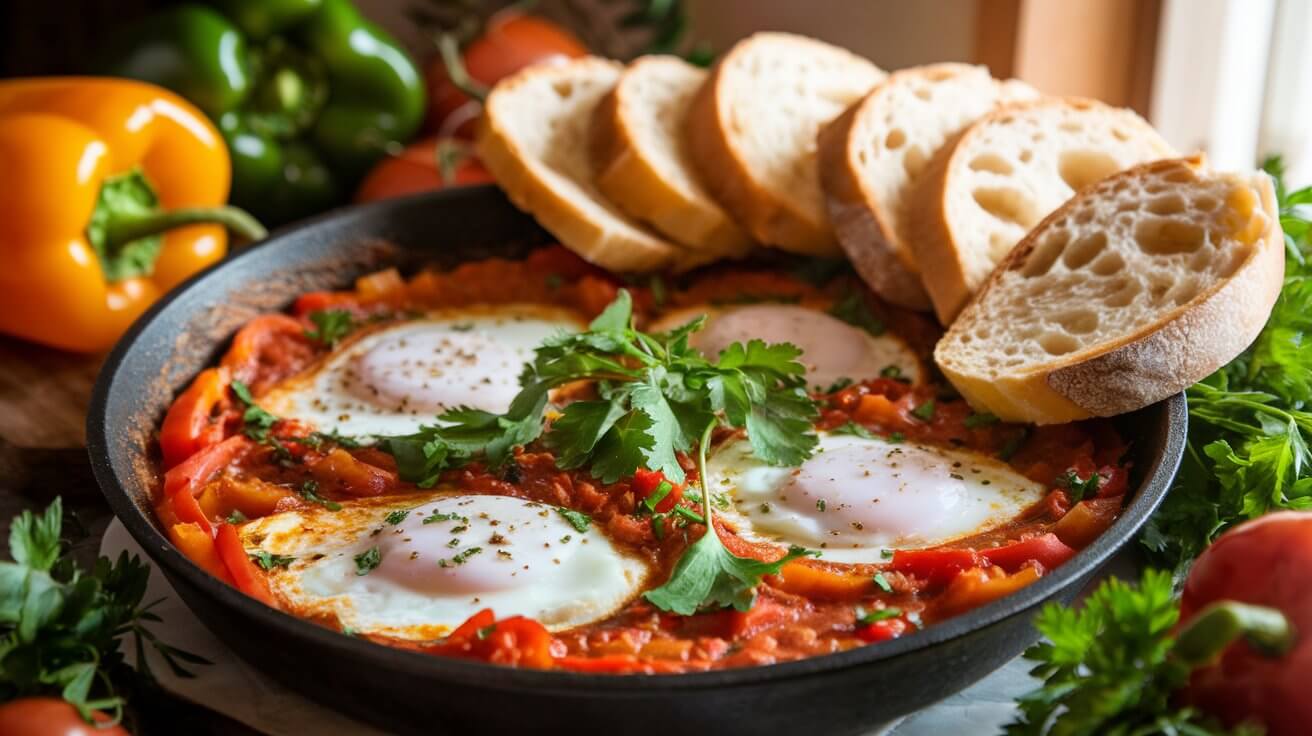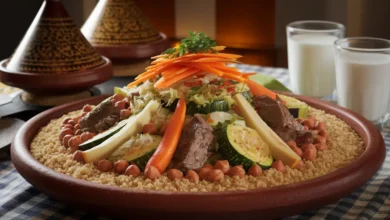Shakshuka Secrets: Master This Flavorful Classic

Introduction: Discovering the Magic of Shakshuka
Shakshuka, a vibrant and flavorful dish of eggs poached in a sauce of tomatoes, peppers, and spices, has captured the hearts and palates of food lovers around the world. This one-pan wonder, with its origins in North Africa and the Middle East, has become a global sensation, gracing brunch menus and dinner tables alike. In this comprehensive guide, we’ll explore the rich history, cultural significance, and mouthwatering variations of shakshuka, along with tips and tricks to help you master this delectable dish in your own kitchen.
The Origins of Shakshuka: A Culinary Journey Through Time
Ancient Roots
While the exact origins of shakshuka are debated, many food historians believe its roots can be traced back to the Ottoman Empire. The word “shakshuka” is thought to come from Arabic, meaning “a mixture” or “shaken.”
North African Influence
Shakshuka as we know it today is believed to have originated in Tunisia. From there, it spread to other parts of North Africa and the Middle East, with each region adding its own unique twist to the dish.
Israeli Adoption and Popularization
In the 1950s, Tunisian Jews brought shakshuka to Israel, where it quickly became a staple of Israeli cuisine. Its popularity in Israel has played a significant role in introducing shakshuka to a global audience.
The Cultural Significance of Shakshuka
Shakshuka is more than just a delicious meal; it’s a dish steeped in cultural significance:
Symbol of Home and Comfort
In many Middle Eastern and North African households, shakshuka is a go-to comfort food, often associated with family gatherings and lazy weekend breakfasts.
Culinary Diplomacy
As a dish shared by various cultures in the Middle East and North Africa, shakshuka has become a symbol of culinary diplomacy, highlighting shared traditions across different communities.
Versatility in Dining
Shakshuka’s adaptability makes it suitable for breakfast, lunch, or dinner, reflecting the flexible eating habits of many Mediterranean cultures.
The Nutritional Profile of Shakshuka
Shakshuka isn’t just delicious; it’s also packed with nutrients:
Eggs
- High-quality protein
- Rich in vitamins B12, D, and E
- Good source of selenium and zinc
Tomatoes
- High in lycopene, an antioxidant linked to heart health
- Good source of vitamins C and K
- Contain potassium and folate
Bell Peppers
- Excellent source of vitamin C
- Contain vitamin A and antioxidants
Olive Oil
- Rich in heart-healthy monounsaturated fats
- Contains antioxidants
Spices
- Many spices used in shakshuka, like cumin and paprika, have anti-inflammatory properties
The Classic Shakshuka Recipe: A Foundation for Creativity
Let’s start with a classic shakshuka recipe that serves as a perfect base for variations:
Ingredients:
- 2 tablespoons olive oil
- 1 large onion, diced
- 2 red bell peppers, seeded and diced
- 4 garlic cloves, minced
- 2 teaspoons ground cumin
- 2 teaspoons paprika
- 1/4 teaspoon red chili flakes (optional)
- 1 28-ounce can whole peeled tomatoes
- Salt and pepper to taste
- 6 large eggs
- 1/4 cup fresh parsley, chopped
- 1/4 cup fresh cilantro, chopped
Instructions:
- Heat olive oil in a large skillet over medium heat. Add onion and bell peppers, cooking until softened, about 5 minutes.
- Add garlic, cumin, paprika, and chili flakes (if using). Cook for another minute until fragrant.
- Pour in the canned tomatoes, crushing them with your hands as you add them. Season with salt and pepper. Simmer for 10-15 minutes until the sauce has thickened.
- Make 6 wells in the sauce and crack an egg into each. Cover and cook for 5-7 minutes, or until the egg whites are set but the yolks are still runny.
- Sprinkle with chopped parsley and cilantro. Serve hot with crusty bread.
Tips for Perfect Shakshuka Every Time
Choosing the Right Pan
A wide, shallow skillet or cast-iron pan works best for shakshuka. This allows for even heat distribution and easy serving.
Egg Doneness
The key to great shakshuka is perfectly cooked eggs. For runny yolks, cook just until the whites are set. For firmer yolks, cook for a few minutes longer.
Seasoning
Don’t be shy with the spices. Taste the sauce before adding the eggs and adjust the seasoning as needed.
Serving
Serve shakshuka directly from the pan for a rustic, family-style meal. Provide plenty of bread for dipping.
Shakshuka Variations: Exploring Global Flavors
Once you’ve mastered the classic recipe, it’s time to get creative. Here are some exciting variations to try:
Green Shakshuka
Replace the tomato sauce with a base of sautéed leafy greens like spinach, kale, or Swiss chard.
Mexican-Inspired Shakshuka
Add black beans, corn, and jalapeños to the sauce. Top with queso fresco and cilantro.
Mediterranean Shakshuka
Include artichoke hearts, olives, and feta cheese for a Mediterranean twist.
Shakshuka with Meat
Brown some ground lamb or merguez sausage before adding the vegetables for a heartier version.
Indian-Spiced Shakshuka
Use garam masala, turmeric, and ginger in place of cumin and paprika for an Indian-inspired flavor profile.
Beyond Breakfast: Creative Uses for Shakshuka
While shakshuka is often associated with breakfast or brunch, it’s versatile enough for any meal:
Shakshuka Pasta
Toss cooked pasta with shakshuka sauce for a quick and easy dinner.
Shakshuka Pizza
Use shakshuka as a pizza topping, adding eggs in the last few minutes of baking.
Shakshuka Sandwich
Stuff pita bread with shakshuka for a portable meal.
Shakshuka Burrito
Wrap shakshuka in a large tortilla with avocado and cheese for a fusion dish.
Pairing Shakshuka: Complementary Flavors and Textures
Shakshuka pairs well with a variety of sides and beverages:
Bread Pairings
- Crusty baguette
- Pita bread
- Challah
- Sourdough toast
Side Dish Pairings
- Israeli salad
- Roasted eggplant
- Hummus
- Labneh (strained yogurt)
Beverage Pairings
- Mint tea
- Turkish coffee
- Arak (anise-flavored spirit)
- Light red wines like Pinot Noir
The Economics of Shakshuka: From Street Food to Gourmet Dish
Shakshuka’s rise in popularity has had interesting economic impacts:
Restaurant Industry
Many upscale restaurants now offer gourmet versions of shakshuka, often at premium prices.
Meal Kit Services
Shakshuka has become a popular option in meal kit delivery services, introducing the dish to even more home cooks.
Cookware Industry
The popularity of shakshuka has led to an increase in sales of cast-iron skillets and other suitable cookware.
Sustainability and Ethical Considerations
As with any dish, there are sustainability considerations when it comes to shakshuka:
Egg Sourcing
Choosing eggs from free-range or pasture-raised chickens can make the dish more ethical and potentially more nutritious.
Seasonal Ingredients
Using seasonal, locally-sourced vegetables for the sauce can reduce the carbon footprint of the dish.
Reducing Food Waste
Shakshuka is an excellent way to use up slightly overripe tomatoes and peppers, helping to reduce food waste.
Shakshuka in Popular Culture
Shakshuka has made its mark on popular culture:
- It’s frequently featured on food blogs and Instagram, often as a showcase of rustic, photogenic cooking.
- Several celebrity chefs, including Yotam Ottolenghi and Jamie Oliver, have popularized their own versions of shakshuka.
- The dish has been featured in numerous food documentaries exploring Middle Eastern and North African cuisine.
Shakshuka Around the World
As shakshuka has gained global popularity, it has been adapted in various ways:
United States
American versions often include additions like avocado or bacon.
United Kingdom
British interpretations sometimes incorporate local sausages or baked beans.
Australia
Australian cafes have embraced shakshuka, often serving it with sourdough toast and a side of avocado.
Japan
Some Japanese versions use miso paste in the sauce for an umami boost.
Frequently Asked Questions About Shakshuka
Can shakshuka be made ahead of time?
The sauce can be made ahead and reheated, with fresh eggs added just before serving.
Is shakshuka spicy?
Traditional shakshuka has a mild to moderate level of spice, but you can adjust the heat to your preference.
Can I make shakshuka without eggs?
Yes, you can enjoy the flavorful sauce on its own or with alternatives like tofu for a vegan version.
What’s the best way to reheat shakshuka?
Gently reheat the sauce on the stovetop and add fresh eggs, or microwave individual portions carefully to avoid overcooking the eggs.
Can shakshuka be frozen?
The sauce can be frozen, but it’s best to add fresh eggs when reheating and serving.
Health Benefits of Shakshuka
Beyond its delicious taste, shakshuka offers several health benefits:
High in Protein
The eggs in shakshuka provide a good source of protein, essential for muscle health and satiety.
Rich in Vitamins and Minerals
The combination of vegetables and eggs offers a wide range of vitamins and minerals, including vitamin C, vitamin K, and potassium.
Heart-Healthy
The olive oil and vegetables in shakshuka contain compounds that may support heart health.
Low in Carbohydrates
Shakshuka is naturally low in carbohydrates, making it suitable for various dietary needs.
Cooking Shakshuka for Special Diets
Shakshuka can be adapted for various dietary requirements:
Vegetarian
Traditional shakshuka is already vegetarian-friendly.
Vegan
Replace eggs with tofu or chickpeas for a vegan version.
Gluten-Free
Shakshuka is naturally gluten-free; just be sure to serve with gluten-free bread options.
Keto
Shakshuka fits well into a ketogenic diet due to its low carbohydrate content.
Conclusion: The Timeless Appeal of Shakshuka
From its humble origins in North Africa to its current status as a global culinary sensation, shakshuka has proven to be more than just a passing food trend. Its delicious flavor, nutritional benefits, and versatility have secured its place in kitchens and restaurants around the world.
Whether you’re a shakshuka purist who swears by the classic recipe or an adventurous foodie eager to try new variations, there’s a shakshuka out there for everyone. So the next time you’re looking for a satisfying, flavorful meal that works for breakfast, lunch, or dinner, consider whipping up a pan of shakshuka.
Remember, the best shakshuka is the one made with love and shared with good company. So gather your friends and family, crack some eggs, and enjoy the simple pleasure of this timeless dish. From the first dip of bread into the savory sauce to the last scrape of the pan, shakshuka is sure to become a favorite in your culinary repertoire.
Bon appétit, or as they say in Arabic, Bil hana wash shifa!




